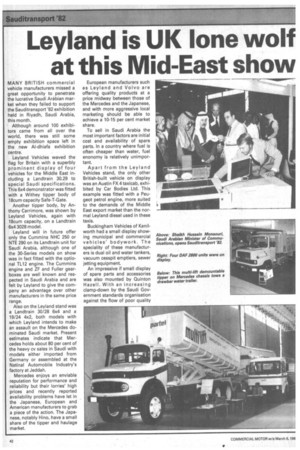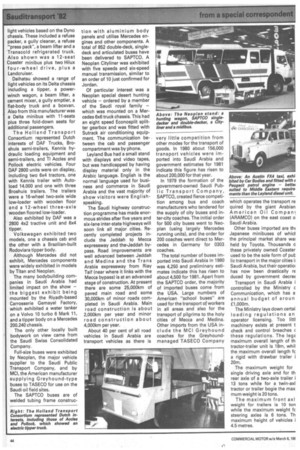Leyland is UK lone wolf at this Mid-East show
Page 34

Page 35

Page 36

If you've noticed an error in this article please click here to report it so we can fix it.
MANY BRITISH commercial vehicle manufacturers missed a great opportunity to penetrate the lucrative Saudi Arabian market when they failed to support the Sauditransport '82 exhibition held in Riyadh, Saudi Arabia, this month.
Although around 100 exhibitors came from all over the world, there was still some empty exhibition space left in the new Al-dhiafa exhibition centre.
Leyland Vehicles waved the flag for Britain with a superbly prominent display of four vehicles for the Middle East including a Landtrain 30.29 to special Saudi specifications. This 6x4 demonstrator was fitted with a Withey tipper body of 18cum capacity Safe-T-Gate.
Another tipper body, by Anthony Carrimore, was shown by Leyland Vehicles, again with 18cum capacity, on a Landtrain 6x4 3028 model.
Leyland will in future offer only the Cummins NHC 250 or NTE 290 on its Landtrain unit for Saudi Arabia, although one of the 30-Series models on show was in fact fitted with the optional TL12 engine. The Cummins engine and ZF and Fuller gearboxes are well known and respected in Saudi Arabia and are felt by Leyland to give the company an advantage over other manufacturers in the same price range.
Also on the Leyland stand was a Landtrain 30/28 6x4 and a 19/24 4x2, both models with which Leyland intends to make an assault on the Mercedes dominated Saudi market. Present estimates indicate that Mercedes holds about 80 per cent of the heavy cv sales in Saudi with models either imported from Germany or assembled at the Natinal Automobile Industry's factory at Jeddah.
Mercedes enjoys an enviable reputation for performance and reliability but their lorries' high prices and recently reported availability problems have let in the Japanese, European and American manufacturers to grab a piece of the action. The Japanese, notably Hino, have a small share of the tipper and haulage market. Apart from the Leyland Vehicles stand, the only other British-built vehicle on display was an Austin FX 4 taxicab, exhibited by Car Bodies Ltd. This example was fitted with a Peugeot petrol engine, more suited to the demands of the Middle East export market than the normal Leyland diesel used in these taxis.
Buckingham Vehicles of Kenilworth had a small display showing municipal and commercial vehicles' bodywork. The speciality of these manufacturers is dual oil and water tankers, vacuum cesspit emptiers, sewer jetting equipment.
An impressive if small display of spare parts and accessories was also mounted by Quinton Hazell. With an increasing clamp-down by the Saudi Government standards organisation against the flow of poor quality spare parts from South East Asia, Quinton Hazell should be well placed to expand its business in Saudi Arabia.
Quinton Hazell is also aiming to expand its business supplying all types of vehicle servicing equipment. Quinton Hazell can offer very competitive prices on certain types of equipment by using its extensive bulk purchasing facilities. The largest national presence at the exhibition was made by the USA with over 20 companies participating under the sponsorship of the US Depart ment of Commerce and held under the auspices of the American .Embassy. Obviously this kind of government backing considerably eases the problems faced by American exhibitors, in particular small companies or companies seeking agents or representatives in Saudi Arabia. Kenworth had Three 6x4 tractive . units on display and has achieved considerable penetration of the heavy tractor segment of the Saudi market with this model.
International Harvester showed a Paystar 5000 6x4 tractive unit, a Holmes wrecker on an International S1700 chassis, an International S1800 all-steel flatbed truck plus a 52500 chassis cab unit while Mack had a 6x4 R/685 SK model on display.
From the Japanese manufacturers, Toyota and Mitsubishi had the biggest presence. Mitsubishi showed seven vehicles including a Galant L200 pickup, a Fuso NP 118J 4x2 tipper with 6.2cum 10-ton body and two Fuso NP 123J 4x2s, one with 7cum 11-ton tipper and one with 12-ton flatbed body. The Fuso 6x4 range was represented by a NV 125S 12cum 25-ton tipper. Of particular interest in the Fuso range was the convenient positioning of the spare wheel (shown in accompanying photographs).
Toyota showed a range of light vehicles based on the Dyno chassis. These included a refuse packer, a gully cleaner, a refuse "press pack", a beam lifter and a TranscoId refrigerated truck. Also shown was a 12-seat Coaster minibus plus two Hilux four-wheel drive, plus a Landcruiser.
Daihatsu showed a range of light vehicles on its Delta chassis including a tipper, a powerwinch wagon, a beam lifter, a cement mixer, a gully emptier, a flat-body truck and a boxvan. Also from this manufacturer was a Delta minibus with 11-seats plus three fold-down seats for additional passengers.
The Holland Transport Consortium represented Dutch interests of DAF Trucks, Broshuis semi-trailers, Kennis hydraulic loading equipment and semi-trailers, and TI Accles and Pollock electric vehicles. Four DAF 2800 units were on display, including two 6x4 tractors, one with Kennis trailer with Autoload 14.000 and one with three Broshuis trailers. The trailers were a 16-wheel two-axle wide low-loader with wooden floor and a 12-wheel three-axle wooden floored low-loader.
Also exhibited by DAF was a 2800 4x2 tractive unit and 6x4 tipper.
Volkswagen exhibited two models, one a chassis cab and the other with a Brazilian-built Rodoviara tipper body.
Although Mercedes did not exhibit, Mercedes components were widely exhibited in models by Titan and Neoplan.
The many bodybuilding companies in Saudi Arabia had limited impact on the show — the biggest exhibit being mounted by the Riyadh-based Carrosserie Gemayel Factory, which exhibited a water tanker on a Volvo 10 turbo 6 Mark 11, and a tipper body on a Mercedes 200.240 chassis.
The only other locally built bodywork on view came from the Saudi Swiss Consolidated Company.
Full-size buses were exhibited by Neoplan, the major vehicle supplier to the Saudi Public Transport Company, and by MCI, the American manufacturer supplying Greyhound-type buses to TASECO for use on the Saudi oil field sites.
The SAPTCO buses are of welded tubing frame construc tion with aluminium body panels and utilise Mercedes engines and other components. A total of 852 double-deck, singledeck and articulated buses have been delivered to SAPTCO. A Neoplan Cityliner was exhibited with five speeds and six-speed manual transmission, similar to an order of 10 just confirmed for Jordan.
Of particular interest was a Neoplan special desert hunting vehicle — ordered by a member of the Saudi royal family — which was mounted on a Mercedes 6x6 truck chassis. This had an eight speed Econosplit splitter gearbox and was fitted with Sutrack air conditioning equipment. The communication between the cab and passenger compartment was by phone.
Leyland Bus had a small stand with displays and video tapes, but was handicapped by having display material only in the Arabic language. English is the normal language used for business and commerce in Saudi Arabia and the vast majority of show visitors were Englishspeaking.
The Saudi highway construction programme has made enormous strides after five years and six-lane inter-state highways will soon link all major cities. Recently completed projects include the Jeddah to Mecca expressway and the-Jeddah bypass. Road improvements are well advanced between Jeddah and Medina and the Trans Arabia expressway from Riay Taif (near where it links with the Mecca bypass) is at an advanced stage of construction. At present there are some 25,000km of paved main road and some 30,000km of minor roads completed in Saudi Arabia. Main road construction is about 2,000km per year and minor road construction about 4,000km per year.
About 40 per cent of all road vehicles in Saudi Arabia are transport vehicles as there is very little competition from other modes for the transport of goods. In 1980 about 156,000 transport vehicles were imported into Saudi Arabia and government estimates for 1981 indicate this figure has risen to about 200,000 for that year.
In 1979 the formation of the government-owned Saudi Public Transport Company, SAPTCO, created fierce competition among bus and coach manufacturers who tendered for the supply of city buses and inter-city coaches. The initial order for 500 city buses went to Neoplan (using largely Mercedes running units), and the order for 200 coaches went direct to Mercedes in Germany for 0303 coaches.
The total number of buses imported into Saudi Arabia in 1980 was 4,250 and preliminary estimates indicate this has risen to about 4,500 for 1981. Apart from the SAPTCO order, the majority of imported buses come from the USA. Large numbers of American "school buses" are used for the transport of workers in all areas and also for the transport of pilgrims to the holy cities of Mecca and Medina. Other imports from the USA include the MCI Greyhound coaches for the Greyhoundmanaged TASECO Company which operates the transport re quired by the giant Arabian American Oil Compan) (ARAMCO) on the east coast o Saudi Arabia.
Other buses imported are ON Japanese minibuses of whici the principal market share we; held by Toyota. Thousands c these privately owned Coaster used to be the sole form of puL lic transport in the major cities Saudi Arabia, but their operatiol has now been drastically rE duced by government decreE Transport in Saudi Arabia i controlled by the Ministry c Communication, which has a annual budget of aroun £1,000m.
The Ministry lays down certai loading regulations an operator licensing. Too littl machinery exists at present t check and control breaches these regulations. The legE maximum overall length of th tractor-trailer unit is 18m, whir the maximum overall length fc a rigid with drawbar trailer i 20m.
The maximum weight for single driving axle and for th rear axle of a two-axle trailer i 13 tons while for a twin-axl tractor or trailer bogie the max mum weight is 20 tons.
The maximum front axl weight for trailers is 10 ton while the maximum weight fc steering axles is 6 tons. Th maximum height of vehicles i 4.5 metres.
































































